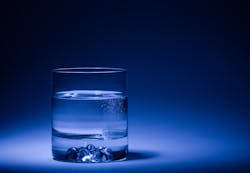California water regulators approved the world’s first requirements for testing microplastics in drinking water sources.
CalMatters reports that testing will begin with only source waters. This excludes the water that providers send to people’s taps after treatment, according to Scott Coffin, a research scientist with the State Water Resources Control Board.
This decision comes after years of research.
The State Water Resources Control Board unanimously approved a policy handbook for testing water supplies for microplastics over four years. Now, under the approved plan, up to 30 of the state’s largest water providers will be ordered to start quarterly testing for two years beginning in the fall of 2023, reported CalMatters.
“There’s no other place in the world — literally in the world — that has standardized methods for how you do this or has a monitoring program to look at drinking water,” said Steve Weisberg, executive director of the Southern California Coastal Water Research Project, which analyzed testing methods, reported CalMatters. “California is really getting out there and being first.”
The list of agencies that must begin testing is still a draft, reported CalMatters, but water providers have been selected based on their size and the degree of water treatment. The monitoring locations will likely be finalized after public input this year.
Included in the list are the Metropolitan Water District of Southern California, which serves 19 million people, and the Los Angeles Department of Water and Power, the East Bay Municipal Utility District and the San Francisco Regional Water System.
The new requirements come after a state law adopted in 2018, which required four years of testing to determine how widespread microplastics are in drinking water, as well as guidelines establishing safe drinking levels.
“We’ve known about the issue for decades. The public has been asking for governments to do something about it for a good 10 or 15 years. It’s been a bottleneck at the science and we, through our efforts, have been able to bring the science up to a level of maturity that is finally ready to be used in a regulatory sense,” Coffin said, reported CalMatters.
The policy handbook the board adopted lays out a timeline for the testing. After an initial, year-long pilot phase for testing, sampling methods and training, monitoring is expected to take place in two, two-year phases. Water systems must alert the public to microplastics detections in their annual Consumer Confidence Reports as well, reported CalMatters.
CalMatters reported the water board’s standardized testing method is estimated to cost water systems between $1,000 and $2,000 per sample.
“The use of new methods would require a demonstration study and place the burden of cost and efforts to conduct the study onto the public water systems,” said the Association of California Water Agencies and California Water Association in a joint letter to the board, reported CalMatters. “The human health effects from microplastics is a statewide issue, and therefore justifies use of state funds to supplement the cost born by public water agencies to participate in this process.”
But the concern is about the smaller particles evading treatment, Coffin told the board, reported CalMatters. The first two years of monitoring will be followed by six months of evaluation. This will ensure the contamination is properly evaluated and then whether treated drinking water should be evaluated in the next phase with other testing methods, according to Coffin.
“We are not expecting to find any significant contamination because our watershed is well-protected and all of our water is filtered before delivery to the public,” said Susan Teefy, East Bay Municipal Utility District’s water-quality manager, reported CalMatters.
In order to develop a standardized test for microplastics, the Southern California Coastal Water Research Project sent jars of water with different types of microplastics and other substances to laboratories around the world.
One test involves "evaluating the particles under a microscope to determine their size, shape, color and number; the other involves beaming a laser to determine precisely what they’re made of," reported CalMatters.



